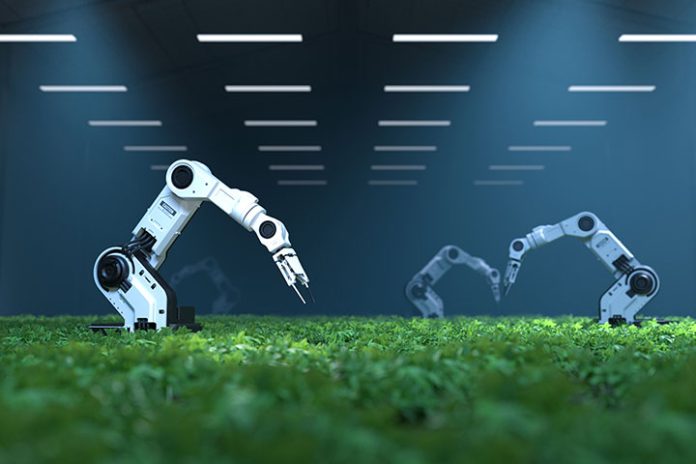Trends in the use of AI: Artificial Intelligence has been growing in all sectors, especially in agribusiness. To give you an idea, in 2020, the Food and Agriculture Organization of the United Nations (FAO) relaunched a commitment with the companies IBM and Microsoft to develop AI with a focus on food security. The aim is to reach the target of feeding a global population of almost 10 billion by 2050.
In other words, exploring the main trends and advances for 2024 on the integration of Artificial Intelligence (AI) in agriculture is necessary to understand what is happening in the sector and, which investments to make and understand the main challenges in the area.
With this in mind, below, we have separated five impactful ways in which AI technology is transforming the agricultural sector, offering innovative solutions to the challenges faced by farmers.
1. Optimization Of Agricultural Production
One of the primary uses of AI this year that will extend into next year is the optimization of planting, cultivation, and harvesting processes. This is because technology in this sector allows the maximization of food production in a sustainable way with quality and food safety.
This means that, with the use of tools that feature AI, producers can improve business management in real-time. Because, with data and information available through technologies, they are able to have a systemic view of the crop and make the best decisions for the planting, cultivation, and harvesting processes.
Furthermore, there is access to greater predictability due to the use of sensors, monitoring and machine learning, which consequently reduces loss costs and also increases product quality.
To give an example, the use of AI reduces technical visits to check machines by 5% to 30% and increases daily employee productivity by 20% to 30%.
Also Read: Artificial Intelligence In Hybrid Work
2. Crop Forecasting And Management
As we said above, from the moment the producer uses AI in their production, this technology is capable of predicting and managing harvests, more assertively and predictably, with only data as guidance.
Therefore, with this type of intelligent management, losses are minimized, and efficiency in resource allocation is maximized, as technological tools will dictate the right moment, time, and quantity of resources to be used.
For example, using AI in your farming will inform the right time that the plants should be irrigated, and with a team of data analysts, the best irrigation model for agriculture is arrived at, aiming at the quality of the crop, type of soil, fertilization, climate forecasts, and cost optimization.
Therefore, the use of drones and satellites is essential, as they allow farmers to monitor their crops remotely, identifying areas that need irrigation and fertilization in real-time.
3. Monitoring And Controlling Pests And Diseases
Other trends in the use of AI in the field in 2024 are the monitoring and control of pests and diseases, a challenge that still keeps many farmers up at night. In other words, a market bet is the dissemination of tools that use AI to proactively identify, track, and control pests and diseases, reducing the use of agrochemicals and promoting more sustainable agricultural practices.
In this way, with remote sensing, it is possible to monitor the crop, and from the first symptom of a pest or disease, an alert is generated so that the maintenance team can take combat action.
In this sense, AI sensors can identify pests and diseases, provide insights into which herbicides to apply, and define the right area to combat them.
Remember that the sensors also help define the correct dosage of herbicides so as not to affect the quality and add excessive toxins to the food.
Furthermore, the AI evaluates variables such as weather conditions, temperature, water use, or soil conditions in real-time to provide evidence of how the infestation began and also generate insights into what to do in the next harvest to avoid this problem.
4. Precision Agriculture And Data-Driven Decision Making
Highlighted in 2023, Precision Agriculture or AP is one of the best for 2024 as well. This technique, together with AI, allows the collection and analysis of data in real-time, providing valuable insights for making strategic decisions in the field, from irrigation management to seed selection.
In this process, the data collected by technological tools, such as drones, are essential for the decisions to be made and also for more strategic definitions. Because they offer images in real-time, speeding up the process and bringing more efficiency to the field.
Therefore, precision agriculture, also known as innovative or digital agriculture, is one of the current techniques essential for crop productivity. By using the model’s techniques and practices, producers are able to reduce costs and losses and make more assertive investment decisions.
5. Automation Of Agricultural Tasks
Last but not least, one of the trends in AI use in 2024 is how this technology is driving the automation of agricultural tasks, from operating heavy machinery to sorting harvested produce.
This means that repetitive manual work in the field will give way to the use of AI tools that increase efficiency and reduce operational costs.
However, this does not mean that “robots” have taken over agriculture. Humans are also necessary for the processes, and no matter how much manual labour is replaced, analytical vision is essential for analyzing the data collected.
In other words, professionals leave the manual and go strategic. AI facilitates many activities and provides several advantages, but together, it must have the experience of producers and agricultural professionals to use these advantages in the best way.
Therefore, understanding what benefits the integration of AI in agriculture promises for 2024 is necessary, as the adoption of this technology can not only boost productivity but also contribute to more sustainable and ecologically conscious agricultural practices.
Therefore, it is essential to be informed and also rethink investments that take into account what the agribusiness market has been asking for.
Also Read: How Does Artificial Intelligence Improve The Customer Experience?


